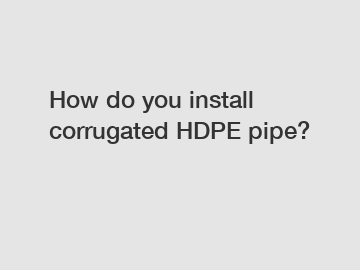Feb. 09, 2024
Rubber & Plastics
SINCO contains other products and information you need, so please check it out.
Corrugated HDPE (High-Density Polyethylene) pipes have gained immense popularity in the field of drainage and agricultural applications due to their numerous benefits, such as durability, flexibility, and cost-effectiveness. Whether you are a seasoned professional or a DIY enthusiast, proper installation techniques are key to ensuring the longevity and performance of these pipes. In this blog, we will delve into a step-by-step guide for installing corrugated HDPE pipes, sharing expert insights and best practices along the way.
1. Assessing the Site and Environment:

Before initiating the installation, a thorough evaluation of the site is crucial. Consider factors like soil conditions, water table levels, environmental regulations, and any potential obstacles that may affect the project. This initial assessment ensures a seamless installation process and mitigates potential difficulties down the road.
2. Preparing the Trench:
Once the site assessment is complete, it's time to dig the trench. The depth and width of the trench should align with the recommended specifications from the manufacturer. Additionally, the trench should have a smooth, uniform bottom, and the sides should be stable to prevent any future settlement or disruptions.
3. Selecting the Right Pipe:
Choosing the proper corrugated HDPE pipe for the intended application is crucial. Consider factors such as pipe diameter, length, and stiffness class as per industry standards. Consulting with suppliers or experts will help you select the ideal pipe to meet your specific requirements.
4. Connecting Pipes:
Begin the installation by connecting the pipes. Carefully align the pipes, ensuring that the ends fit snugly together. Utilize appropriate couplings or connectors recommended by the manufacturer for a tight and secure joint. Properly sealed joints are vital to prevent water infiltration and ensure smooth flow.
5. Aligning and Leveling:
During installation, it is crucial to maintain a consistent pipe slope, keeping gravity in mind. It ensures optimal drainage and prevents the accumulation of debris or stagnant water. Use a level or laser-guided equipment to achieve accurate alignment and even pipe elevation throughout the system.
6. Installing Proper Bedding:
To provide support and stability to the corrugated HDPE pipe, it is essential to create a solid bedding system. Place a layer of granular material, such as sand or aggregate, beneath and around the pipe. This bedding acts as a cushion, helping distribute external forces uniformly and reducing stress on the pipeline.
7. Backfilling and Compaction:
Once the pipe is properly positioned and bedded, gradually backfill the trench with suitable material such as granular fill or select backfill as recommended. Tamp the material in thin layers, ensuring adequate compaction at regular intervals to prevent future settling or structural damage.
8. Employing Effective Joining Techniques:
To simplify installation processes and prevent potential leaks, employing advanced joining methods like heat fusion or mechanical joining systems can be advantageous. Heat fusion ensures leak-proof connections by creating a homogeneous bond, while mechanical joining methods provide flexibility and ease of maintenance.
9. Performing Quality Checks:
After completion, conduct thorough inspections to ensure the integrity of the installation. Verify that the pipes are free from deformities, cracks, or any visible damage. Additionally, check joint connections, pipe slope, and compaction levels to guarantee adherence to recommended standards.
10. Post-Installation Maintenance:
To maximize the lifespan and performance of corrugated HDPE piping systems, regular maintenance is essential. Monitor the system periodically for any signs of maintenance requirements, such as soil erosion, sediment buildup, or potential blockages. Promptly address any issues to avoid costly repairs or system failures.
Conclusion:
Mastering the art of installing corrugated HDPE pipe involves meticulous planning, attention to detail, and adherence to industry best practices. By following these expert guidelines, you can confidently undertake your piping projects, ensuring optimal performance, long-lasting durability, and efficient drainage systems. Remember, consulting with professionals and relying on trusted suppliers is crucial throughout the installation process. With proper installation, you can embrace the countless benefits that corrugated HDPE pipes offer, contributing to sustainable infrastructure development.
For more information, please visit pipe floats.
Previous: Which innovative applications deserve 1mm PTFE sheets?
Next: Which innovative HDPE pipe float design sparks environmental debate?
If you are interested in sending in a Guest Blogger Submission,welcome to write for us!
All Comments ( 0 )